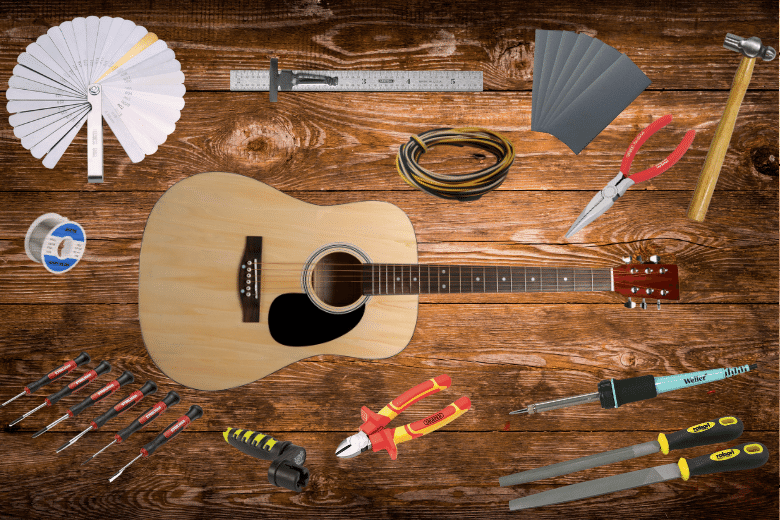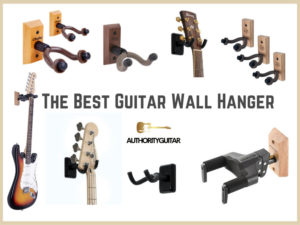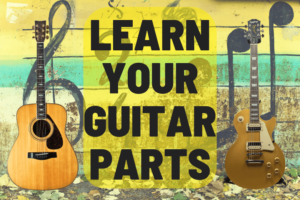Have you ever wanted to know how to fix and maintain your own guitar without having to take it to the guitar tech?
Maybe you want to save a bit of cash but found the task daunting.
But looking after your own guitar is pretty easy if you know how.
I’ve been playing around with guitars for over 25 years, and over this time have taught myself many aspects of guitar setup. This has come about purely through necessity rather than wanting to learn.
You don’t need years of experience to maintain your own instruments. Just the correct tools and the knowledge of what to do with them.
My tool guide provides the basic tools required enabling you to set up your instruments to your own specifications. Every tool on my list is required to look after your guitar.
My recent in depth post Learn How To Set Up A Guitar In 12 Steps is a thorough look into all the aspects involved in the intonation process. If you are looking for more advanced techniques on guitar setup.
Let’s start with the basic essential tools every player should own:
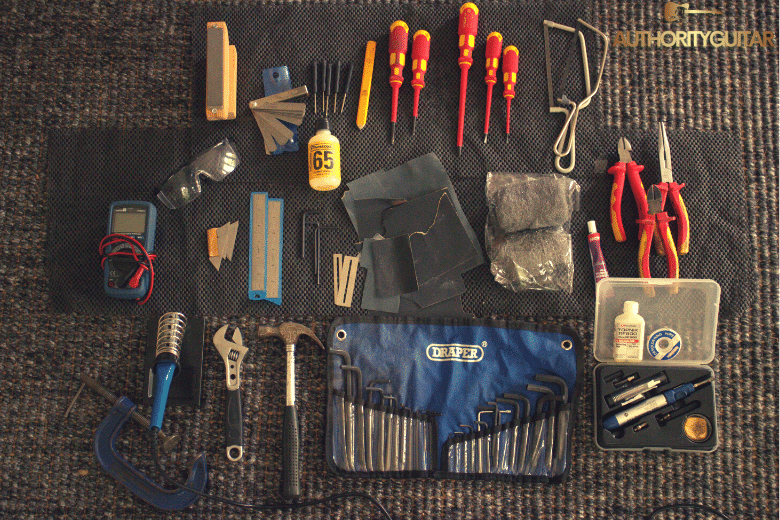
Basic Tools
- Tuner
- Diagonal Cutters
- Needle Nose Pliers
- Capo
- Allen Keys
- Steel Rule in 64ths
- Feeler Gauge
- Crosshead Screwdrivers
- String Winder
Intermediate/Guitar Tech
- Single Cut Mill File
- Needle Files
- Junior Hacksaw Blade
- Stanley Knife Blades
- Soldering Iron
- Resin Core solder
- De-Soldering braid
- Screened and Single Core cable
- Sandpaper
- Carbide Paper
- Wire wool
- Epoxy Resin
- Pin Hammer
Basic Guitar Setup Tools
1- Tuner
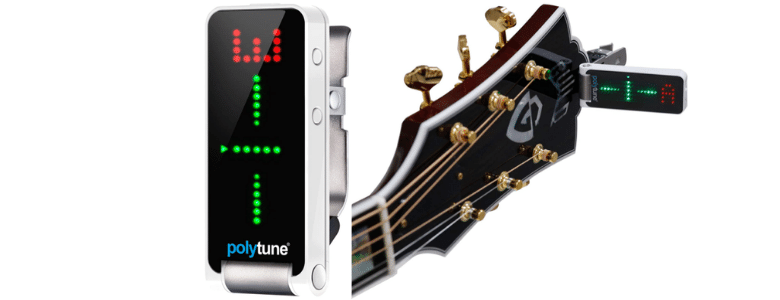
TC Electronic Guitar Tuner (Clip On)
A must have guitar maintenance tool which you can’t do without is a guitar tuner. If you’ve ever tried to tune your acoustic guitar by ear, you know how difficult it can be. Does anybody still do this?
The importance of using an electronic tuner for both electric guitar and acoustic guitars cannot be understated. Using a phone tuner app is not accurate enough!
A decent tuner ensures the intonation of your instrument is perfect, and before you start trying to fix other problems.
However, you don’t need to spend a fortune on a tuner. There are many cost effective options available from both digital and traditional models.
There are a range of tuners that are specifically designed for different porpoises. Check out our article here if you need help with that: Best Guitar Tuners
Here is my favorite: Perfect for Acoustic, Electric and Bass Guitars
2- Diagonal Cutters

Draper 50838 160mm Vde Slimline Diagonal Side Cutter
These are one of the most important tools you need when maintaining your guitar. They’re great for cutting strings, removing parts, removing rivets for electronics, etc.
I like a decent quality of cutters as the blades and grip will last you years. Avoid the cheap models if you can.
I would stay away from the very cheapest cutters as they dont last long. If you need to do any wite striping you’ll require a half decent cutters. I swear by Draper tools.
My recommendation for Diagonal Cutters would be:
2b- Needle Nose Pliers

Draper Redline 160 mm Long Nose Pliers
Needle Nose Pliers, also called “tweezers”, come in handy for guitar repair and maintenance.
Tweezers can help with a variety of tasks such as: string installation, adjusting saddle height on bridges, tightening rotating machine heads (also called tuning machines), and many more!
They’re also much more efficient than trying to fit your oily chubby fingers in tiny nooks and crannies.
I would stay away from the very cheapest cutters as they dont last long. If you need to do any wite striping you’ll require a half decent cutters. I swear by Draper tools.
My recommendation for Long Nose Pliers would be:
3- Capo

Kyser Quick-Change Capo
A capo is an important part of setting up a guitar. You need a third hand to help with string adjustments. If you’ve got three hands then ignore this.
You’ll need a capo on the 1st fret to measure the guitar’s neck relief.
There are various ways to check neck relief, but this approach will work for most novices in most cases.
I’ve had the same Capo for probably 10 years. It’s an absolute beast for both Acoustic and Electric Guitars. I couldn’t recommend it more.
See our favorite Capos here: Best Capo: Everything You Need To Know
4- Allen Keys

Draper 25 piece Metric/Imperial Combined Hexagon Key Set
A set of Allen Keys specific to the guitar generally come with the guitar. But not always so owning a full set is ideal.
Allen keys are essential for truss rod adjustment and setting up certain tremolo bridges. They can also be used to adjust the lock nut.
I have a full set but it’s best to check your own guitar specs to see what fits your requirements before buying anything.
You can’t go wrong with Draper
5- Steel Rule Graduated In 64ths Of An Inch

Inch Flex Precision Stainless Steel Ruler, Chrome
Used to measure the 1st and 6th strings at the 12th fret to determine the height of the action.
Also used at the nut and really handy for tiny changes. Aids with fret buzz and other horrible unwanted problems you guitar gets into.
Make sure you purchase a Rule with 64ths as it makes it so much easier to get your heights spot on
6- Feeler Gauge

Stainless Steel Feeler Gauge
A certain amount of neck relief is required to allow clearance for string vibration. Get yourself a proper set of feeler gauges to precisely ensure your guitar has the correct amount of Bow and reverse bow.
This measurement is extremely important to get right. It’s also the beginning of the set up process.
7- A Selection of Crosshead Screwdrivers.

Steelman Precision Steel Shaft Screwdriver Set
Here’s where you can save a bit of money.
Lower priced screwdrivers are fine for guitar maintenance. If you’re thinking of starting a little business, then get yourself a reliable set.
Screwdrivers are so handy. You need them for your scratchplate, tuning pegs, strap holder, adjusting pickup height..the list goes on.
Ensure you get a few sizes and you should be fine.
8- String Winder

Ernie Ball Pegwinder
It’s so much quicker to wind your stings on using one of these String Winder contraptions.
They cost next to nothing and last forever. A handy little tool to save the life of your wrist
What Tools Do Guitar Techs Use?
If you feel you have working knowledge of the major components of your guitar. You may want to try playing around with other, more complex skills.
Guitar set up is a skill you can learn over a long period of time with a trial and error approach. Using an old guitar is the way to home in on your skills and practice.
Take a look at the tools you’ll be needing for a complete guitar setup. The following tools you would find a Guitar Tech would use.
Intermediate Setup Tool Guide
1- Single Cut Mill File

REXBETI 16Pcs Premium Grade T12 Drop Forged Alloy Steel File Set
A single cut mill file is one of the most versatile guitar tools available since it can be used for pretty much every task, including sharpening frets and cutting string slots.
It has a handle on top with rows of saw-like teeth that are spaced out horizontally (with occasional small gaps).
Each row is cut by hundreds of tiny ‘teeth’ that leave small grooves in the surface of what is being filed.
The file also has a flat edge on one side, so it can be used for flattening and straightening as well as other tasks.
2- Set Of Needle Files

REXBETI 16Pcs Premium Grade T12 Drop Forged Alloy Steel File Set
A set of needle files are essential for guitar setup and repair. These files can be used to file down sharp fret ends, remove uneven frets, or above all, they can be used to work on the nut slots.
Though there are many different types of files you might use on your guitars, needle files tend to give much smoother results.
They also have finer teeth which means you have more control over each pass, and they’re easier to keep track of as well.
3- A Junior Hacksaw Blade

Superior Tools Spare Blades
Junior hacksaw blades can be used to make careful cuts in a guitar body, neck, or other parts.
These blades need to be used with extreme care as they are very sharp and the metal is thin. They are also typically used for cutting fret boards, pickups, and other fine jobs.
3b Stanley Knife Blades

Stanley 11-921 10-Pack
A Stanley blade is commonly used to help remove frets (whereby taking off the old strings and removing rust), as well as general surface preparation for finishing.
A Stanley blade will not distort the steel on the instrument making it ideal for fretboard work.
The blade is extremely sharp, and should be handled carefully after repeated use.
A Stanley blade can also be applied with a wood block to the back of the neck to remove finish build up or for general shaping of the neck contour, especially on Stratocaster models.
I use a stanley blade to clean my frets, the results are fantastic!
A very handy little tool indeed.
4- A Smooth File or Gentlemen’s Hacksaw

Corona Mill Smooth Cut File
The Gentlemen’s Hacksaw is a flat file. It’s made for fileting (making notches) on wood and/or plastic, like touching up fret ends or filling out the neck pocket to get your neck to sit flush with the body.
The Smooth File is also traditionally used for slimming down fingerboards and dovetail necks, but I have also found that the Edge Pro guys will use a Smooth File to smooth out a glue joint that’s been clamped up too tight.
It’s also good to have a couple of smaller diameter files on hand for dressing up small tops and backs, getting into tighter areas where large files won’t fit.
5- 35-Watt Soldering Iron

Weller WP35 35-Watt Professional Soldering Iron
This is a soldering iron that is small enough to maneuver into the tight quarters on a guitar.
They put out 35 watts of heat and are perfect for circuit board repairs, as well as other work on electronics.
Normally you would use rosin-core solder with this type of iron, which contains resin in the center of the wire to help the solder flow.
The soldering iron melts the rosin in the solder which then flows into whatever it is being soldered, ensuring a strong connection.
You can find 35-watt Soldering Irons at most hardware stores
You’ll Also Require:

Small Extras
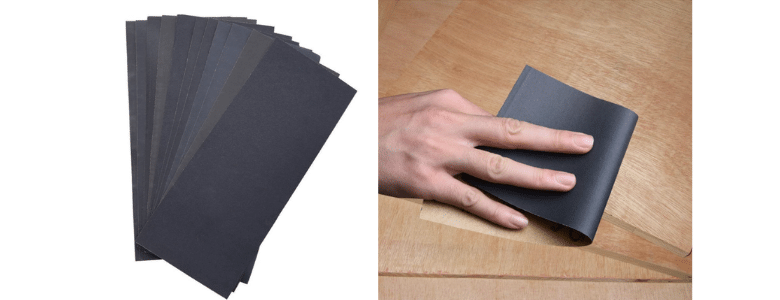
1100-1200 grade Wet or Dry Sandpaper
I am often asked what I recommend for finishing a guitar after leveling, re-frets or any other level of restoration.
In order to get the best possible results. Using a serious amount of wet or dry sandpaper down to fine grits is a very important part of getting a smooth and durable finish on your guitar.
Some people think that only the very high grit sandpaper is good enough for this process, but in reality you need to start at a coarse grit and work down until you get to a fine grit, which in my opinion should be somewhere around 1100 or 1200 grade wet or dry sandpaper.
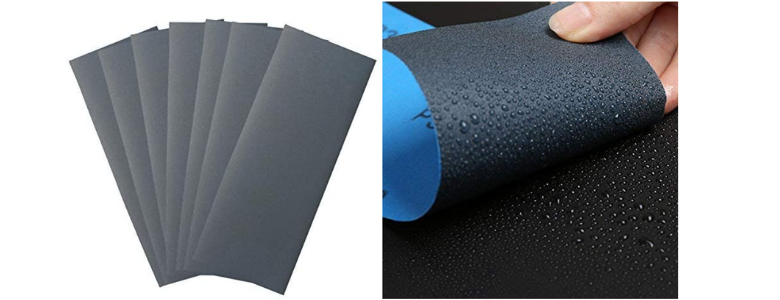
360-grade silicon carbide paper
Silicone Carbide abrasive paper is one of the most versatile tools in any guitar tech’s toolbox, and it will make your life a lot easier when working on guitars.
You can use it to make custom radius sanding blocks, you can use it to polish frets, and you can even use it to build a super-fine buffing wheel for getting rid of those stubborn nicks on the guitar body.

000 Grade Wire Wool
Another one of the most commonly used and resourceful tools in guitar repairs is 000 grade wire wool.
Wire wool can be used on metal, wood and plastics to clean, buff and/or polish surfaces to a high sheen.
It’s an essential tool for both repair and maintenance jobs on guitars. Wire wool works like sand paper without leaving impurities on the surface.

Tube of Super Glue/Epoxy Resin
Super glue can be used to fix items that need a strong bond.
This is especially useful if the broken item has already been drilled with holes for screws or nails, like in the guitar bridge.
The superglue will fill up the hole and create an excellent bond between the piece and the surface below it.
This is extremely useful for more complex repairs, like replacing a fret or a neck and screwing them back in place.
It can also be used to fill small gaps between surfaces of different thicknesses before putting on nuts and bolts.
For example, if you had two pieces of wood with different thicknesses and you wanted to attach screws into the thinner piece, the super glue can be used to fill in the gap between them so they are flush.
If you want to attach two surfaces which do not have holes already drilled for nails or screws, use either hot glue or epoxy resin.

Small Pin Hammer
A small pin hammer is a tool devised for minimal damage upon impact to guitar hardware.
For example, when you have an old-school style Tune-O-Matic bridge with large pins going through the body of your guitar, hitting it with a standard hammer will leave a noticeable impression in the wood that is very difficult to remove.
This can be irritating when trying to refinish the guitar.
Ready Made Guitar Tool Kits: For The Basics
Collecting various tools in a short period of time can be expensive. Depending on what you want to achieve. There is an alternative, and that’s a ‘Ready Made’ tool kit.
They definitely serve a purpose for players wanting to do the bare minimum. Although the parts within these packs are cheap, they are still good enough for maintaining the everyday guitar requirements.
I’ve handpicked the best setup kit at various prices:
What Is Included In A Guitar Setup?
There are many factors that go into a guitar setup, including:
The Assessment Procedure
- Tuning and Strings
- Action Height
- Neck Relief
- Truss Rod Adjustment
- Fingerboard Nut Measurement
- Bridge Height Check
- Final Truss Rod and Action Adjustment
- Playing Test
- Perform Fret Dress If Required
- Intonation Check
- Adjust Pick Up
- Setting Up Tremolo, Spring, and String Tension
See Authority Guitar Full Guitar Setup: Learn How To Set Up Your Guitar In 12 Steps
Can You Set Up A Guitar Yourself?
Yes! If you have the knowledge and patience to read up on what you need to do there is no reason why you can’t set up a guitar yourself.
Just don’t start with your ‘working’ guitar. Get yourself a cheap guitar from a yard sale to practice on first.
Guitar setup is a fine balance between your playing style and the instrument suitability.
These are factors that only you can determine, as few people share the same requirements.
Instruments have limitations, so it’s important to know what you can and cannot achieve by altering them.
For example, before you attempt to adjust a truss rod or dress the frets, you need to understand how a string tension affects neck relief.
It is essential to develop the eye and feel to determine which modifications are necessary.
The skills are readily learned, but take time and practice to master.
When Is It Better To Get A Guitar Set Up By A Professional?
As with everything, there are good reasons to get a guitar set up by a professional.
The main reason that it is worth getting a guitar set up by a professional is for the experience of someone who knows what they’re doing being able to achieve an optimum playing and sound quality from your instrument.
If you don’t want to put in the time to learn how to do it yourself, this is a good reason. The techs are generally worth their weight in gold.
There are also some cases where it can actually damage your guitar if you try and set it up yourself.
If the bridge on your guitar is poorly set up then tightening or loosening the strings can cause damage that will require professional attention. It really is easy to make a mess of the guitar’s intonation if you don’t know what you’re doing.

